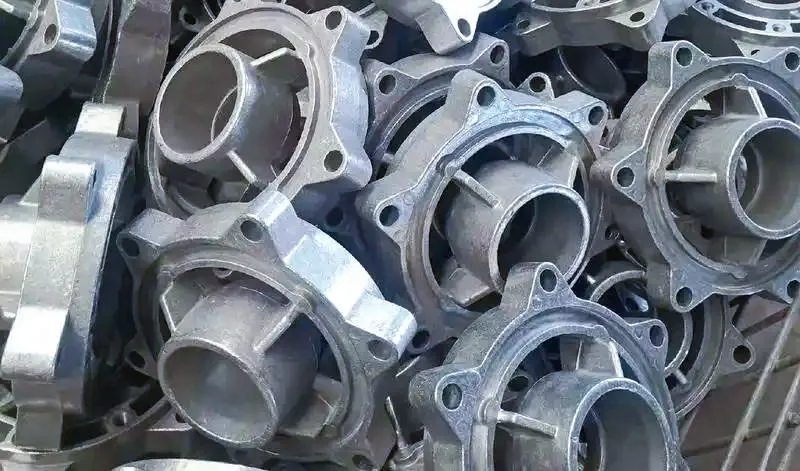In manufacturing, 6061 aluminum alloy is widely used for its balanced mechanical properties. In contrast, ADC12 aluminum alloy die-cast parts are commonly considered alternatives due to the die-casting process’s high efficiency and ability to produce complex geometries. However, a material substitution is never a simple swap; it must be evaluated comprehensively based on performance, process capability, and application conditions.
This article analyzes whether 6061-machined parts can be replaced by ADC12 die-cast parts, detailing the key engineering considerations and scenarios where conversion is not recommended.

1. First Step: Understand the Fundamental Differences Between ADC12 and 6061
Although both are aluminum alloys, their material characteristics and manufacturing processes differ significantly—this is the foundation of evaluating feasibility.
ADC12: A “high-efficiency” aluminum die-casting alloy
A standard alloy for high-pressure die casting (HPDC), ideal for near-net-shape complex components such as cylinder head covers or sensor brackets. Its high silicon content (9.6%–12%, per GB/T 15114-2021) provides excellent melt fluidity, enabling stable filling in thin-wall and complex cavities. However:
- Low ductility (elongation 3%–5%)
- Poor weldability
- Possible surface issues after machining due to silicon precipitation (e.g., grey powdery appearance)
6061: A “multi-performance” wrought aluminum alloy
Produced mainly via extrusion and then CNC-machined to final precision. Key advantages include:
- Excellent machinability (suitable for precision milling, drilling, tapping; achievable tolerance ±0.01 mm, IT5)
- Excellent weldability (joint strength up to 85% of parent metal)
- Mg content (0.8%–1.2%) delivers superior corrosion resistance (neutral salt spray ≥500 hrs per ISO 9227)
- High toughness (elongation ≥12% in T6 condition)

2. Three Critical Factors Before Replacing 6061 with ADC12 Die Casting
1) Mechanical Performance Compatibility
Toughness & Load-Bearing
6061 has significantly higher ductility than ADC12 (12% vs. 3–5%). If the product experiences dynamic loads or impacts, such as:
- Drone frames
- Robotic joints
- Structural brackets
ADC12 (brittle, low-impact strength) may crack or fail.
Corrosion Resistance
6061 performs significantly better in harsh environments:
- Outdoor
- High humidity
- Mild acid/alkali
- Marine atmosphere
ADC12 typically survives only 100–200 hours of salt spray before corrosion initiates.
Surface & Post-Treatments
6061 is suitable for:
- Hard anodizing
- Decorative anodizing
- High-adhesion electroplating (up to 5B per ASTM D3359)
ADC12 is not stable in anodizing due to high silicon content, commonly resulting in:
- Patchy color
- Darkened surface
- Inconsistent coating thickness
This is critical for consumer electronics housings, optical components, and related components.
2) Process Compatibility: Die Casting vs. CNC Machining
Structural Complexity
ADC12 Die Casting: Best for complex 3D geometries, thin walls, integrated structures, and near-net-shape components. Cycle time ≤30 seconds; material utilization >95%.
6061 Extrusion + CNC Machining: Best for linear or profile-based geometries.
If the original 6061 part is simple, switching to ADC12 may increase tooling costs—die-casting mold costs usually range from USD 20,000–50,000+.
Machining Accuracy
6061 is suitable for:
- High-precision milling
- Boring
- Tapping
- Surface finishing up to Ra0.4µm
ADC12 (HPDC) usually achieves:
- Dimensional accuracy IT6–IT8
- Natural casting tolerance ±0.1–0.3 mm (GB/T 6414)
- Possible porosity, shrinkage cavities, flash
Not suitable for high-precision components unless additional CNC machining is added.
3) Cost & Production Volume
ADC12 is cost-effective for large-volume production (≥500,000 pcs/year).
6061 is more economical for small–medium batches due to low tooling cost (extrusion dies ~USD 1,000–3,000).
If the volume is small, switching to ADC12 may increase the total cost due to the expense of die-casting tooling.
3. Three Application Scenarios Where ADC12 Cannot Replace 6061
1) High-Impact / Structural Load Applications
Examples:
- UAV frames
- Automotive suspension parts
- Mechanical transmission components
6061 absorbs impact energy (Charpy V-notch ~10 J), while ADC12 often fails at 2–3 J.
2) Parts Requiring Welding
6061: Excellent weldability (porosity <1%).
ADC12: High silicon causes severe porosity (5–10%), cracks, and weak joints (180–220 MPa vs. 6061’s ~310 MPa).
Therefore unsuitable for:
- Frame welding
- Tube–tube joints
- Pressure vessels
- Structural assemblies
3) Precision Parts or High Corrosion-Resistance Components
Examples:
- Medical device components (must withstand repeated sterilization)
- Marine hardware
- Precision instrument housings
- High-gloss anodized surfaces
ADC12 fails in corrosion, plating, and high-precision requirements.
4. Summary: The “Golden Rule” of Substitution
Switching from 6061 to ADC12 only works when:
- ✔ Complex geometry
- ✔ Large-volume production
- ✔ Low welding/corrosion requirements
- ✔ Moderate structural load
Do not replace if the application involves:
- ✘ Impact load / structural strength
- ✘ Welding
- ✘ High-precision machining
- ✘ Marine/harsh environments
- ✘ High-end surface finishing (anodizing/electroplating)
Engineering validation (strength test, salt spray test, surface-treatment test) is recommended before mass production.


